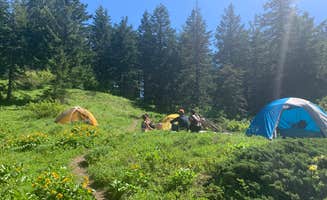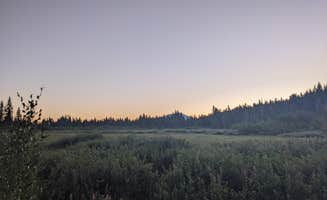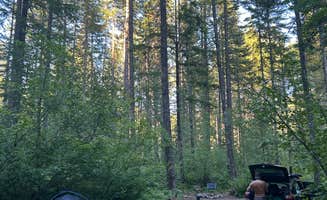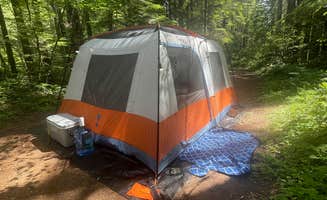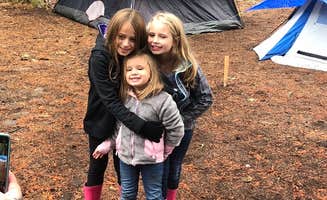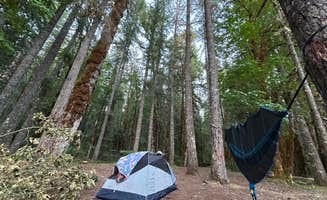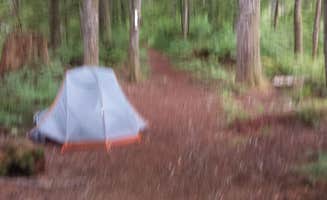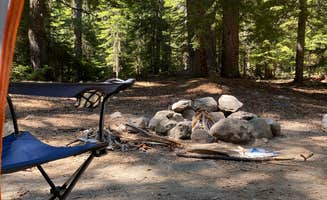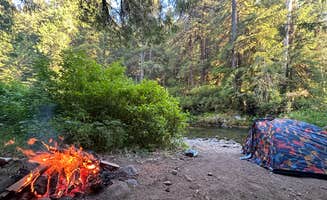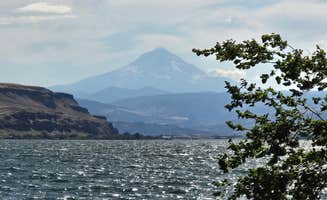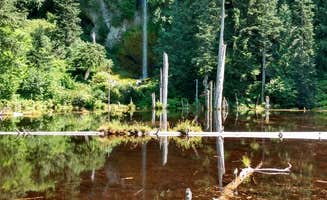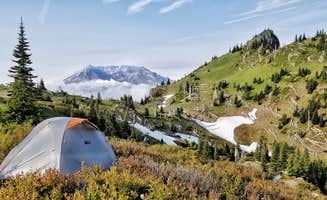Primitive camping near Trout Lake, Washington offers forested sites with elevations ranging from 1,900 to 3,500 feet within the Gifford Pinchot National Forest. Most locations maintain cooler temperatures than surrounding lowlands, with summer highs typically reaching 75-85°F during the day but dropping to 45-55°F overnight. The camping season generally runs from late May through October, with heaviest visitation occurring from mid-June through Labor Day.
What to do
Hiking to waterfalls: Multiple trailheads near Panther Creek Creekside Camp provide access to stunning waterfall views within 1-2 miles of walking distance. "There are several sights that get secluded from others with a very short drive off the main road," notes Joe M., who recommends exploring the creek-side terrain.
Wildlife observation: Dawn and dusk provide optimal wildlife viewing times when deer, elk and smaller mammals are most active. "We did also see elk in area coming from south on NF 9038," reports Mav S. about the Gifford Pinchot National Forest Dispersed Site.
Stargazing opportunities: The limited light pollution makes this area excellent for astronomical viewing. Todd J. mentions that Oldman Pass Sno-Park "feels isolated enough" despite being relatively close to roads, creating good conditions for night sky viewing.
What campers like
Privacy between sites: Many campers appreciate the spacing between primitive sites. Brooks H. notes about NF-65 National Forest Dispersed Site: "Plenty of spots available... Beautiful trees and foliage with obvious sites on side of road."
Natural sound barriers: Creek and river noise provides a natural buffer between camping areas. Alex R. from Panther Creek Creekside Camp shares: "Ice cold creek, towering trees. Seemed to be lots of sites off the road to pick from."
Established clearings: Most sites feature pre-existing fire rings and cleared tent spaces. "This site is amazing people have already set things up for tent camping," reports Mav S. about Gifford Pinchot National Forest Dispersed Site, adding that there's "a fire pit with rocks. Plenty of firewood in woods."
What you should know
Required permits: Northwest Forest Pass or America the Beautiful Pass required for parking at most trailheads and many dispersed sites. At Dispersed Camping above Panther Creek Falls, Sarah S. confirms: "To access it, as you are driving on NF 65 you will see a small road to the right just a bit before you see the parking for Panther Creek Falls also on the right."
Road navigation challenges: Forest service roads vary in quality with many requiring higher clearance. Shawna B. notes about Gifford Pinchot National Forest: "There are multiple sites along the road, some have plenty of room for RVs but I wouldn't want to drive one on the roads."
Water sources: Water must be carried in or filtered from creeks. Pack enough containers for your stay or bring filtration systems. "The water is cold; I think it may be snow melt," mentions Audrey M. about water sources near dispersed camping areas.
Bathroom facilities: Most sites lack facilities entirely. Israel S. reports about Oldman Pass Sno-Park: "vault bathroom close by but there was no toilet paper so bring your own."
Tips for camping with families
Accessible sites for children: Some areas offer easier access for families with young children. According to Lindsey N., Little Soda Springs Rd Dispersed "has 2-3 free sites you can drive in and, 2 more walk-in sites near the bridge. It was so nice on a super hot day and there is a nearby latrine at the trailhead!"
Temperature preparation: Nights remain cool even in summer. Madeline N. shares about Dispersed Camping above Panther Creek Falls: "It was cold and rainy so we didn't have any issues being out in the open."
Safety considerations: Cell service is virtually non-existent, requiring advance planning. Johny B. advises: "there's absolutely no cell service, so make sure to download any maps or trail guides before you get there."
Tips from RVers
Site selection for larger vehicles: Limited level areas exist for RVs. "I wouldn't want to drive one on the roads," cautions Shawna B. about the forest roads, though she notes there are "multiple sites along the road, some have plenty of room for RVs."
Turning radius limitations: Many forest roads have tight turns and limited turnaround spots for trailers. "There is space for RV but I recommend your really good with it," suggests Mav S., indicating the technical driving skills needed for larger rigs.
Surface considerations: Many sites have uneven, rocky terrain that may require additional leveling equipment. Israel S. notes that camping at some sites "does feel like camping in a Parking lot," which may actually benefit some RV campers needing flat surfaces.


